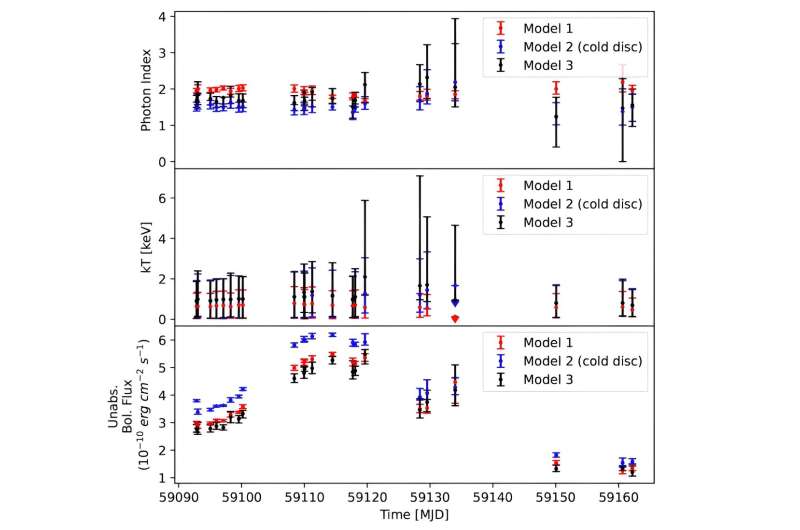September 20, 2023 report
This article has been reviewed according to Science X's editorial process and policies. Editors have highlighted the following attributes while ensuring the content's credibility:
fact-checked
preprint
trusted source
proofread
Astronomers investigate spectral evolution of XTE J1810–189

Using the Neutron star Interior Composition Explorer (NICER) onboard the International Space Station (ISS), European astronomers have performed spectral analysis of a low-mass X-ray binary known as XTE J1810–189. Results of the study, available in a research paper published September 13 on the preprint server arXiv, shed more light on the spectral evolution of this system.
X-ray binaries (XRBs) are composed of a normal star or a white dwarf transferring mass onto a compact neutron star or a black hole. Based on the mass of the companion star, astronomers divide them into low-mass X-ray binaries (LMXBs) and high-mass X-ray binaries (HMXBs).
XTE J1810–189 is a neutron star LMXB estimated to be located between 11,400 and 28,400 light years away. It is a transient source, which alternates between quiescent phases and periods of increased X-ray emission due to accretion on the neutron star.
In September 2020, an X-ray outburst of XTE J1810–189 started and lasted about three months. A team of astronomers led by Arianna Manca of the University of Cagliari in Italy, has observed XTE J1810–189 during this outburst in order to better understand its spectral evolution.
"In this paper, we studied the spectral evolution of the NS LMXB XTE J1810–189 during its latest outburst. We analyzed NICER data in the 1–10 keV energy range, modeling the emission with an absorbed, thermally Comptonized component, and with a different model composed by a cold, Comptonized disk and black body," the researchers wrote in the paper.
The astronomers managed to conduct 33 NICER observations of XTE J1810–189 during the 2020 outburst, and 23 of them had an exposure long enough to provide sufficient statistics for spectral analysis. The study found that 22 of these observations can be well fit by an absorbed, thermally Comptonized component whose photon index slightly varies in time, reaching its highest value towards the end of the outburst.
The temperature of the Comptonized black body was found to be about 0.6 keV, which, according to the authors of the paper, can either be a hot disk or the neutron star surface. Therefore, they noted that further investigation is needed to determine whether the seed photons for the Comptonization component are coming from the accretion disk or the neutron star.
Based on the collected data, the researchers concluded that XTE J1810–189 did not reach a full high/soft state during the three-months long outburst and its highest luminosity was measured to be about one undecillion erg/s. NICER observations also revealed the presence of thermonuclear bursts during the outburst phase of XTE J1810–189. The astronomers noted that the duration of these bursts suggests that the system contains a hydrogen-rich main sequence star.
More information: A. Manca et al, Spectral Analysis of the LMXB XTE J1810-189 with NICER Data, arXiv (2023). DOI: 10.48550/arxiv.2309.06831
Journal information: arXiv
© 2023 Science X Network





















